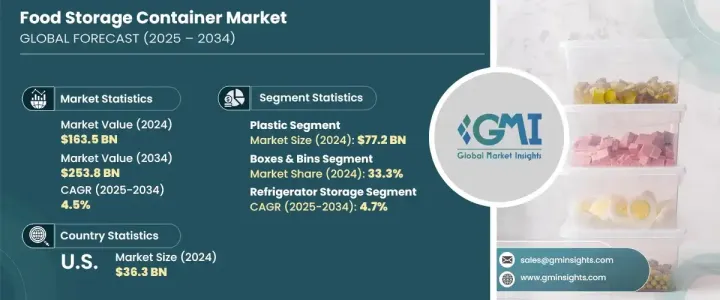
세계의 식품 보관 용기 시장은 2024년에 1,635억 달러로 평가되었으며, 2025년부터 2034년까지 연평균 성장률(CAGR) 4.5%로 성장할 것으로 예측됩니다.
지속 가능성에 대한 소비자 인식이 높아지면서 친환경적이고 재사용 가능한 보관 솔루션에 대한 수요가 증가하고 있습니다. 소비자들은 환경에 미치는 영향을 최소화하는 제품을 점점 더 선호하고 있으며, 제조업체들은 고성능을 유지하면서 폐기물을 줄일 수 있는 혁신적인 대안을 개발해야 합니다. 지속 가능성에 대한 강조가 커지면서 생분해성, 재활용 가능, 무독성 소재를 사용하여 기능성과 환경적 책임 사이의 균형을 맞추고 있습니다. 추적성을 높이고 음식물 쓰레기를 줄이는 스마트 패키징 기술과 같은 첨단 기능이 업계 환경을 변화시키고 있습니다. 소비자가 편의성, 식품 안전, 환경 지속 가능성을 우선시함에 따라 제조업체는 변화하는 선호도에 맞춰 내구성이 뛰어나고 BPA가 없으며 재사용이 가능한 용기를 만드는 데 주력하고 있습니다. 가정 및 상업용 요구를 모두 충족하는 모듈형 및 공간 효율적인 디자인의 채택이 증가함에 따라 시장 성장이 더욱 촉진되고 있습니다.

식품 보관 용기 시장은 플라스틱, 유리, 금속 등으로 분류됩니다. 이 중 유리 부문은 5.8%의 연평균 성장률을 기록하며 2034년까지 850억 달러에 달할 것으로 예상되는 등 상당한 성장을 보일 것으로 전망됩니다. 유리 용기는 무독성 및 BPA가 없는 특성으로 인해 식품 보관을 위한 더 안전하고 지속 가능한 옵션을 제공하면서 큰 인기를 얻고 있습니다. 소비자들은 더 건강한 선택을 우선시하면서 유리 대체재를 선택하고 있으며, 이는 이 부문의 지배력을 더욱 강화하고 있습니다. 또한 유리 보관 솔루션은 내구성이 뛰어나고 냄새에 대한 내성이 있어 유해 화학물질에 대한 노출을 최소화하는 동시에 친환경을 추구하는 가정에서 선호되는 선택입니다.
| 시장 범위 | |
|---|---|
| 시작 연도 | 2024년 |
| 예측 연도 | 2025-2034년 |
| 시작 금액 | 1,635억 달러 |
| 예측 금액 | 2,538억 달러 |
| CAGR | 4.5% |
식품 보관 용기 시장은 상자 및 통, 항아리 및 용기, 병 및 캔, 가방 및 파우치 등 제품 유형별로도 세분화됩니다. 2024년 박스 및 통 부문은 공간 효율성과 정리를 향상시키는 보관 솔루션에 대한 소비자 선호도가 증가함에 따라 전체 시장 점유율의 33.3%를 차지할 것으로 예상됩니다. 가정과 상업 사용자 모두 실용적인 기능, 손쉬운 접근성, 효과적인 공간 관리를 제공하는 용기를 찾고 있습니다. 이러한 제품은 특히 주방과 식료품 저장실의 질서를 유지하면서 식품을 신선하게 보관할 수 있는 편리하고 가치 있는 보관 옵션을 우선시하는 소비자들에게 인기가 높습니다.
2024년 미국의 식품 보관 용기 시장 규모는 363억 달러에 달했습니다. 지속 가능성에 민감한 소비자들은 친환경 보관 솔루션에 대한 수요를 촉진하고 있으며, 소비 후 재활용(PCR) 플라스틱과 식물 기반 대체재 등 재활용 및 생분해성 소재로 만든 용기에 대한 선호도가 높아지고 있습니다. 지속 가능성 정보를 제공하는 QR코드와 재사용 가능한 모듈형 용기와 같은 스마트 기능은 환경적으로 책임감 있는 솔루션을 적극적으로 찾는 미국 소비자들 사이에서 주목을 받고 있습니다. 시장이 계속 진화함에 따라 첨단 소재와 스마트 기술의 통합은 지속 가능성 및 소비자 안전에 대한 강조가 높아지는 추세에 맞춰 식품 보관 관행을 재정의할 것으로 예상됩니다.
The Global Food Storage Container Market reached USD 163.5 billion in 2024 and is projected to grow at a CAGR of 4.5% between 2025 and 2034. Rising consumer awareness about sustainability is driving demand for eco-friendly and reusable storage solutions. Consumers increasingly prefer products that minimize environmental impact, prompting manufacturers to develop innovative alternatives that reduce waste while maintaining high performance. The growing emphasis on sustainability has led to the use of biodegradable, recyclable, and non-toxic materials, ensuring a balance between functionality and environmental responsibility. Advanced features such as smart packaging technologies that enhance traceability and reduce food waste are transforming the industry landscape. As consumers prioritize convenience, food safety, and environmental sustainability, manufacturers are focusing on creating durable, BPA-free, and reusable containers that align with evolving preferences. Market growth is further propelled by the increasing adoption of modular and space-efficient designs that cater to both household and commercial needs.

The food storage container market is categorized into plastic, glass, metal, and others. Among these, the glass segment is anticipated to witness substantial growth, registering a CAGR of 5.8% and reaching USD 85 billion by 2034. Glass containers have gained immense popularity due to their non-toxic and BPA-free properties, offering a safer and more sustainable option for food storage. Consumers are opting for glass alternatives as they prioritize healthier choices, reinforcing the segment's dominance. Glass storage solutions also offer superior durability and resistance to odors, making them a preferred choice for households aiming to minimize exposure to harmful chemicals while promoting eco-conscious practices.
| Market Scope | |
|---|---|
| Start Year | 2024 |
| Forecast Year | 2025-2034 |
| Start Value | $163.5 Billion |
| Forecast Value | $253.8 Billion |
| CAGR | 4.5% |
The food storage container market is also segmented by product type, including boxes and bins, jars and canisters, bottles and cans, bags and pouches, and others. In 2024, the boxes and bins segment accounted for 33.3% of the total market share, driven by increasing consumer preference for storage solutions that enhance space efficiency and organization. Households and commercial users alike are seeking containers that offer practical functionality, easy accessibility, and effective space management. These products are particularly popular among consumers who prioritize convenience and value storage options that keep food fresh while maintaining order in their kitchens and pantries.
The US food storage container market was valued at USD 36.3 billion in 2024. Sustainability-conscious consumers are fueling demand for eco-friendly storage solutions, driving a preference for containers made from recycled and biodegradable materials, such as post-consumer recycled (PCR) plastics and plant-based alternatives. Innovations like smart features, including QR codes that provide sustainability information and modular, reusable containers, are gaining traction among US consumers who are actively seeking environmentally responsible solutions. As the market continues to evolve, the integration of advanced materials and smart technologies is expected to redefine food storage practices, aligning with the growing emphasis on sustainability and consumer safety.